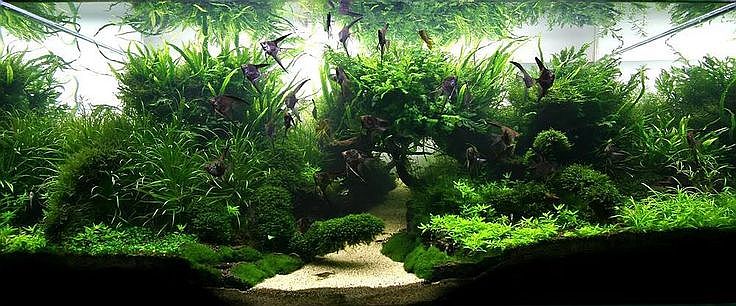Tropical fish keeping enthusiasts the world over covet freshwater angelfish as “the fish to have” in their aquariums.
Freshwater Angelfish are cichlids common to the Amazon region of South America and are one of the more popular species used in starting up new single species aquariums.
Although they add a lot of grace and beauty to a new tank, they are not the easiest fish to care for unless you have already educated yourself about their needs.
Because they grow up to be over 6 inches in length, Angelfish require a large tank preferably planted with live plants and furnished with a piece of driftwood to maintain the soft, slightly acidic water they require.
Angelfish thrive in soft (0.6 to 1.2 dH), slightly acid (pH 6.5 to 6.9) water but have successfully bred in water with a pH of 6.8. Their preferred temperature range is between 74 F to 78 F, but for spawning the water temperatures should be raised to 80 degrees.
- Tank Size
If you plan on breeding angelfish, the minimum size tank needed is 20 gallons, but if you plan to leave the fry with the parents after a successful hatching, you should up-size to a 30 gallon, or better yet a 55 gallon tank setup. A mature breeding pair of angels with several hundred fry to care for would be severely cramped in anything less than a 55 gallon tank, so get the largest tank you can afford. A large tank also provides a sense of security to the fish and minimizes the possibility of the parents eating their offspring.
- Live Plants
Whenever possible, live plants should be included in all freshwater tanks except for those housing African cichlids. Live plants act like a canary that miners used to bring into a mineshaft. They monitor water quality and will die before the fish become ill and when the water quality in the tank becomes inferior. Live plants also help keep the water clear, hinder the growth of unwanted algae and add Oxygen to the water.
Angelfish love to swim around and lay their eggs on Amazon Sword Plants but any broad leaf aquatic plant will do. Amazon Sword Plants (Echinodorus) are indigenous to the flood plains of South America and are in a genus that includes more than fifty hardy and adaptable species. They do well in soft, neutral to slightly acidic water which is what your angelfish require.
Java Moss (Vesicularia dubyana), Water Sprite (Ceratopteris) and Java Fern (Polypodium pteropus) are some other beautiful plants that adapt well to aquaculture and compatible with South American Angelfish.
- Diet
Angelfish are naturally carnivorous in the wild and should be fed protein rich foods to help them grow to optimum size and stay healthy, especially if you plan to breed them. Angelfish can survive on a diet of flake food but will reach breeding condition more quickly if you supplement their diet with bloodworms (tubifex), daphnia, or newly hatched brine shrimp. An occasional sprinkling of shrimp pellets, mosquito larvae, chopped beef heart or earth worms will also be appreciated. Most pet shops sell frozen tropical fish foods for saltwater fish that you can also feed to your freshwater angels. Most commercial breeders are set up to hatch out brine shrimp eggs to feed the parents along with live baby guppies.
- Compatibility
Being a cichlid, angelfish are naturally aggressive to other fish and even their own kind.
When starting a new aquarium, most people will begin with a “community” tank of more than one species. Although angelfish are sometimes included in the mix, they grow quite large and will usually start picking on their tank mates causing other problems. Angelfish are more suited to a single species tank or to a tank with other species (such as Discus) that coexist with them in their natural habitat.
In a community tank it is true that almost any species can adjust to their environment and to their tank mates if they are introduced together, but unless you are accustomed to caring for their special needs, angelfish are one species that should be housed by themselves.
- Breeding
Many varieties of angelfish are now being bred in captivity in several new color variations. If you get the urge to breed angelfish, the most economical way of assuring that you get at least one mated pair is to buy at least six specimens from a tank of young angels. Choose your fish carefully and select only active, strong healthy fish with perfectly formed fins. The top and bottom fins should be straight and their long “feeler fins” should be intact. If possible buy fish that are actively feeding. These grow more quickly and will usually have a higher rate of egg production when they reach maturity. DO NOT buy any fish from a tank with dead fish in it or that show signs of disease.
Once you select your fish, place them in at least a 20 gallon planted aquarium to grow up in. Feed them the high protein diet mix listed above and they will quickly reach maturity.
As the fish mature, they will begin to pair off with each other. At this point you can separate the pair and place them in a breeding tank set up with a clean piece of slate or flower pot and leave them until they commence breeding activity. Breeding can be stimulated by a partial water change and increasing the temperature in the tank to between 80 and 82 degrees F.
The female will begin to show a prominent little nipple like projection (ovipositor) that is a sure sign that spawning is about to commence. The ovipositor at the vent area is where the female deposits her eggs from and in the male, where he fertilizes them.
The pair will start cleaning a spawning site a couple of days before actually laying eggs. When the area is thoroughly cleaned by the fish, the female makes contact with the the slate, flower pot, leaf or whatever and deposits her eggs while the male immediately moves in to fertilize them. After several hundred eggs have been deposited the pair will hover over the eggs and continuously circulate water over them to insure fertilization. Unfertilized eggs turn white and are quickly removed by the parents. Depending on the temperature, egg hatching occurs 36 to 48 hours after fertilization.
If you see some eggs fall off the slate or a leaf where they were laid, you can pick them up with an eyedropper or a turkey baster and squirt them back to where they were or just leave them alone. They will eventually hatch out.
- Egg Hatching and Rearing Fry
If you decide to leave the parents with the eggs, let them alone as much as possible and feed your fish as you normally would. Set up a “seeded” sponge corner filter in a separate bare tank with plenty of aeration for the fry to live in when the eggs hatch. Do not place them in a tank with a conventional side filter or an undergravel filter. Both will suck up the fry and an undergravel filter, despite how clean the tank water looks, is filthy underneath. You can “seed” a corner filter by letting it run in an established tank for a few weeks before you need to use it in the tank for rearing the fry.
After the eggs hatch, drop the fry into the bare aquarium and do not feed them until their egg sacs are absorbed. This usually takes anywhere from 3 to 6 days. Feeding them before then only fouls the water and could create fungus problems. There is a period of time after hatching and before the free swimming stage when the fry will stick together. When this happens increase the aeration in the tank so all the fry have sufficient oxygen. When the egg sacs are absorbed and the fry are free swimming, you can start feeding the fry with newly hatched brine shrimp.
A scrupulously clean aquarium is essential for the health and growth of your Angel fish fry so when the sponge corner filter starts to discolor in the bare tank, rinse it out in a container of tank water, NOT TAP WATER. Clean any sediment from the bottom of the tank daily to prevent ammonia spikes that can kill the fry.
- Types Of Angelfish
Although most mutations of angelfish are lost in nature, tropical fish keepers have been selectively breeding new strains of angelfish for years. The following is only a partial list of what is available today in the tropical fish market.
Silver Angelfish
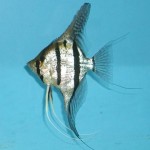
Silver Angel
The Silver Angelfish is the normal coloration of the wild Angelfish that are collected from the Amazon River basin in South America.
It has a silver white body with four black vertical bars running through it. The first bar always passes through the eye.
The picture to the left depicts this common variety but some specimens have black freckles over the top half of their bodies.
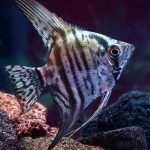
Zebra Angelfish
Zebra Angelfish
Zebra Angelfish have more vertical stripes on them than the Silver Angelfish.
The stripes continue through the tail.
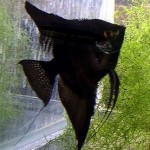
Black Angel
Black Angelfish
These angels are a solid, velvety black variety bred by mating a Black Angel to a Black Lace Angel.
The offspring will be 50% Black and 50% Black Lace. If you mate a Black Angel to another Black Angel you will get 100% Black offspring.
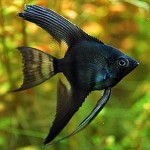
Black Lace Angelfish
Black Lace Angelfish
The Black Lace Angels are the steppingstones to the solid black variety. The primary difference between a Black Lace and a Silver Angel is the intensity of the colors, especially on the fins where you see the lace like effect that gives them their name. When you mate two Black Lace Angels, you can expect to get 25% Black, 50% Black Lace and 25% Silver offspring. The Black Angel fry are very fragile and usually don not survive to the free swimming stage. They should be immediately transferred and cared for separately if they do make it to the free swimming stage.
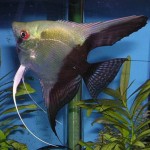
Half Black Angel
Half Blacks
As their name implies, Half Blacks are just that. The forepart of their bodies are white and rear is black. The black cuts right through the top and bottom fins and goes right through the tail.

Pearlscale Veiltail Angel
Veiltail Angels
Veiltail Angels come in all color varieties and all have very elongated fins. Veiltail Angels are bred by mating a Veil Angel with a Silver Angel. The offspring will be half Veil and half Silver. If you breed two Veiltail Angels together, you can expect half of them to be Veil Angels, 25% ordinary Angels and 25% Long Tailed Veil Angels. The Long Tailed Veil Angels will have noticeably longer fins and tails than the Veil. Breeding two Long Tailed Veil Angels together will produce all Long Tailed Veils but they will not be as hearty and they will produce fewer eggs when they spawn. Some Veiltail Angels have fins so long that they become bent and are often broken.
Marble Angels
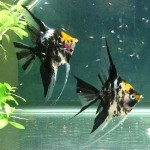
Marble Blushing Angel
Marble Angels have a broken pattern of black and silver that can only be described as Marble.
There may be undertones of golden around the head and back areas but the fins usually have rays of black and white. If you breed a Marble Angel with a Black Lace Angel, some of the offspring will be Black Lace Marble, with the traits of both parents.
Golden Angel
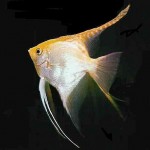
Golden Angel
Golden Angelfish can be all golden in color with no other markings or from a solid silvery white to a gold color. There is usually a gold mantle over the head and back areas.
Blushing Angel
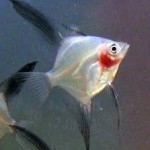
Blushing Blue Angel
Blushing Angels due to selective breeding are the most delicate of angels. They have a red cheek area with no obvious pattern on a white body.
Pearl Scale Angel
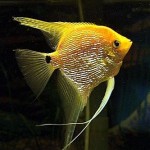
Pearlscale Gold Marble Angel
Pearl Scale Angels are absolutely beautiful fish. They have bumpy almost rough looking scales on their body and come in many color varieties. The are outstanding when shown under suitable lighting.
Don’t let the beautiful delicateness of angelfish fool you. Pairing them with bettas, tetras or guppies in a community tank is not recommended unless you want a bloodbath. Because most beginners start tropical fish keeping with only one species of fish, keeping angelfish may be your best option.
Remember that Angelfish lay lots of eggs and are great parents. They will usually live with their young without fear that they will eat them in their infancy. But, unless you don’t plan on selling angelfish to pet shops or other breeders, you will need a larger tank or tanks to keep all the fish. Despite the challenges they present, Angelfish are less difficult to manage as their other cichlid relatives like Discus.
Provide them with a large well planted tank, keep their water clean, feed them a carnivorous diet and you will have and amazing tropical fish tank to enjoy for a long time.


